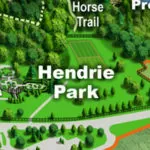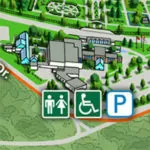| Membership | Price (+HST) |
|---|---|
| Single | $85/year |
| Single Plus | $120/year |
| Family | $130/year |
| Family Plus | $175/year |
| Contributing | $300/year |
| Supporting | $600/year |
| Sustaining | $1,000/year |
| Benefactor's Circle | $2,500/year |
| Director's Circle | $5,000/year |
| President's Circle | $10,000/year |
Slow Down and Smell the β-Damascenone
Dr. David Galbraith (Head of Science, Royal Botanical Gardens)
There is a lot of science involved in sniffing a flower.
Flowers in cultivation have been selected and bred for centuries for several characteristics, including scent. The scent of a flower is not made up of just one chemical compound: sometimes there are hundreds in the aroma of a single blossom. The scent of a Rose (Genus Rosa) is a mixture of dozens of compounds with tonguetwisting names like (-)-cis-Rose Oxide, β-Damascenone, and β-Ionone, among others. Breathing in the familiar smell of a Lilac (Genus Syringa) means encountering [E]-β-Ocimene, Lilac aldehyde, and Lilac alcohol. Even the humble Hyacinth (Genus Hyacinthus) sports compounds like ocimenol, cinnamyl alcohol, and Ethyl 2-methoxybenzoate in its warm spring offerings. In general, these smelly compounds are released from a flower’s petals. Other parts of the plant may smell differently. Some rose stamens, for example, are reported to smell like cloves or musk.
Plants don’t create these chemicals at random. It’s biochemically expensive to produce hundreds of compounds and then let them loose into the atmosphere.
Insects, bats, and other pollinators have evolved responses to specific constellations of these chemical compounds. Along with the appearance of a flower, scent is a crucial means of communication between plants and their ecological partners. And just like people, many flowers have circadian rhythms. They release their scents on a daily cycle keyed to when their pollinating partners show their greatest levels of activity.
People have long picked up on the amazing capability of flowering plants to produce interesting scents. Archaeologists have found an enormous site in Pyrgos, Cyprus where artisans were making perfume out of rosemary, lavender, pine, and coriander, four thousand years ago. They used sophisticated methods like distillation to isolate components from plants
and mix them for their clients. Perfumery today carries on this tradition, a complex art and sophisticated science.
Today some of the most fragrant plants include the Hawaiian Lei Flower, or Frangipani (Plumeria rubra). This grows as a tree or shrub, and its valuable wood can be used to make furniture and musical instruments. Sweet Alyssum (Lobularia maritima) is a common annual and very popular. Its common name in related to its amazing, sweet scent. Chocolate Cosmos (Cosmos atrosanguineus) grows as an herbaceous perennial in warm climates but in
our area can be planted as an annual. Its vanilla-like scent increases through the summer months as days get warmer. Jasmine (Genus Jasminum) can fill a tropical night or a conservatory with a heady aroma. Perhaps the champion
of popularity for scents are roses (Genus Rosa).
The various scents of roses have been treasured for centuries. The Damask Rose (Rosa × damascena) is a hybrid that is considered the “standard rose” for scent. β-Damascenone, a major chemical in the scent of roses, was named after it. It’s a very old rose — it was bred before 1560. Some smell like honey, moss, fruit or green tea. Some are even unpleasant, like the Austrian Briar Rose (Rosa foetida) which has a sharp smell like boxwood. Other more pleasant notable roses for scent are ‘Dark Desire’, a red Hybrid Tea with a strong floral scent, the pink hybrid Rugosa rose ‘Thérèse Bugnet’, with a mild to strong clove fragrance bred in Canada by Georges Bugnet around 1941, and a dark mauve Moss rose, ‘William Lobb’, bred in 1855 by Jean Laffay in France.
Roses change their scent as each flower unfolds.
If you’d like to catch a rose at its most perfumed, sample their fragrance early in the morning on a humid day. Each rose blossom tends to lose its sent as it ages, too. And your perception of a scent may vary from that of others. Our
individual noses are all a little different. Where some people may not smell anything others may be carried away by the experience.
Human memory is deeply keyed to our sense of smell — deep memories can come back to us when we smell familiar scents. Experiencing the joy of
floral scents can form new memories too.
Encountering a garden can be a memorable experience for all of our senses.
Part of RBG at Home
Welcome to RBG at Home, our commitment to offering accessible, diverse and entertaining learning opportunities for all ages.
Ready to get gardening? Our experts can answer your questions, introduce some new DIY projects, and help you connect with the healing power of plants.












